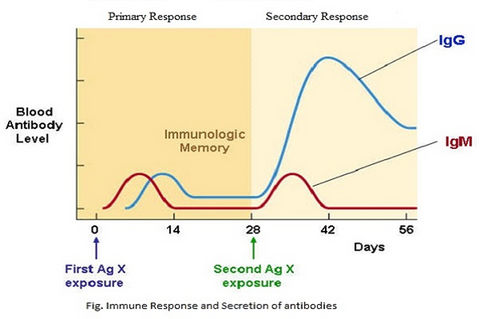The immune system is a complex system of various immune cells designed to protect your body against internal and external threats.
Whether from a cut on your finger or a pathogenic bacterium that's made its way into your respiratory system, the immune system activates to keep you safe and get you back on your feet.
But while most people are aware of what the immune system does, few know the details of how it works.
When the immune system is activated, two systems kick in—the innate immune system, your first line of defense, and your adaptive immune system, which is acquired immunity to an already-encountered pathogen.
But that's not it. Similarly, there are also two types of immune responses: primary and secondary.
Not sure what we mean? That's okay! Keep reading, and we'll dig into the details of the immune system and cover the difference between primary and secondary immune responses. Plus, we'll give you our best tips for keeping your immune system healthy and functioning—even during cold and flu season!
The Basics Of The Immune System
The immune system is one of the most powerful systems in your body, and it's anything but simple. It's specifically designed to keep your body safe and healthy at all times, but many people don't take notice of—or care for—their immune system until a problem and sickness strikes.
But for the most part, illness or infection happens when your immune system has become weak and can't battle the invading pathogens or when an invader is particularly aggressive. In either case, the immune system responds to defeat the threat.
In many instances, your body has not encountered the germs or pathogens and mounts a primary immune response to rid the body of danger—this is your innate immune system reacting to something that's breached one of its barriers.
Although most people think the immune system is one massive system, it's composed of several systems that work in synergy to mount immune responses.
The innate immune system is the body's first line of defense 1; it responds similarly to all foreign substances, hence its name, the "nonspecific" immune system.
It is fast-acting and detects and destroys invading cells within hours of breaching a physical barrier. The innate immune system consists of the following:
- Skin and mucous membranes
- Immune system cells (defense cells) and proteins
The other part of immunity is the adaptive immune system; when the innate immune system struggles to neutralize a pathogen, the adaptive immune system kicks into high gear and targets specific cells that cause infection.
But before it can destroy, it first has to identify. Typically, the adaptive immune response is slower and is triggered in response to pathogens it has already encountered, but it has greater accuracy than the innate system 1.
It has something called immunological memory, which is why people become "immune" to certain illnesses, like chicken pox.
Once the adaptive immune system recognizes a pathogen and has that memory, it can mount a response much quicker the next time it's encountered.
The cells comprising the adaptive immune system differ from the innate immune system and include the following:
- T lymphocytes (T-cells)
- B lymphocytes (B-cells)
- Antibodies (located in the blood and other body fluids)
These two systems work together to maintain health and protect your body from harm. But what comprises the immune system?
Parts Of The Immune System
The immune system comprises various organs, tissues, and proteins that protect the body against invaders. These include:
- White blood cells
- Antibodies
- The Complement system
- The lymphatic system
- Spleen
- Thymus
- Bone marrow
All immune system cells originate in bone marrow, where they mature before migrating to specific tissues, entering the bloodstream, or traveling to lymphatic system vessels 2.
But apart from these organs and tissues, there are also physical barriers involved in the innate immune system that offer first-line protection—the skin, cornea, (eyes), and mucosal barriers of the respiratory, gastrointestinal, and genitourinary tracts.
And once something breaches these physical barriers, one of two immune responses will be triggered: innate or adaptive.
Primary vs. Secondary Immune Responses: What's The Difference?
Much like the two components of the immune system, the immune system elicits two different responses when an invader is encountered: primary or secondary.

Photo source: https://microbiologynotes.com/wp-content/uploads/2015/11/Primary-Vs.-Secondary-Immune-Response.jpg
The primary immune response occurs when the immune system comes in contact with an antigen it's encountering for the first time.
At this time, the immune system learns to recognize and tag the antigen and form antibodies against it, eventually producing memory lymphocytes. This response can take up to 14 days to resolve 3.
The humoral response, which is mediated by B cells with some involvement of T cells, produces high-affinity and antigen-specific antibodies. The CD8 T-cell response, in contrast, generates large numbers of antigen-specific cells that can directly kill infected cells.
In other words, during a primary immune response, naive B-cells are stimulated by the presence of an antigen, become activated, and differentiate into antibody-secreting cells that produce antibodies specific to that antigen.
A secondary immune response, on the other hand, occurs on any subsequent exposure to the same antigen. Because the immune system has already produced antibodies against this antigen and has immunological memory, the body can immediately start producing antibodies against the antigen, making for a faster and more effective response 3.
Simply put, a secondary immune response occurs when a recognized antigen stimulates memory B cells, leading to increased production of specific antibodies produced in the primary response.
Check out the table below for the main differences between primary and secondary immune responses:
| Characteristic | Primary Immune Response | Secondary Immune Response |
| Definition | Immune response when first encountering an antigen | Reaction of the immune system on subsequent encounters with an antigen |
| Appearance | Lymph nodes and spleen | Bone marrow, spleen, and lymph nodes |
|
Occurrence
|
Primary contact with antigen | Second and subsequent exposure to the same antigen |
| Antibody Peak Time | 7-10 days | 3-5 days |
| Responding Cells | Naïve B cells and T cells | Memory B cells |
| Affinity of Antibody | Low affinity for antigen | High affinity for antigen |
| Antibodies | Thymus-dependent and thymus-independent antibodies involved | Thymus-dependent antibodies only |
| Lag Phase | 4-7 days (long) | 1-4 days (short) |
| Types of Antibodies | Large amount of IgM and small amount of IgG | Large amount of IgG and small amount of IgM, IgA, and IgE |
| Amount of Antibodies | Few | 100-1000 times more than primary response |
| Strength of Response | Weaker than secondary | Stronger than primary |
| Antibody Level | Declines to undetectable level | Remains high for longer |
Other Tips For Keeping Your Immune System Healthy
1. Eat a colorful diet
Whole, colorful fruits and vegetables are rich in phytonutrients and antioxidants that support immunity and protect cells from inflammation and oxidative stress 4, 5.
Aim to fill your plate with as much color as possible from food in its least-processed form; the purer, the better.
2. Get enough sleep
Sleep is essential for supporting and strengthening the immune system. Studies show that people who are sleep deprived have weakened immune systems and are at increased susceptibility to illness and infection.6
Aim for 7-9 hours of good quality sleep each night. And if you struggle to fall asleep or stay asleep, check your sleep hygiene practices and implement a solid bedtime routine!
3. Support good gut health
More than 70% of your immune system resides in your gut, so keeping your gut healthy is of the utmost importance for a well-functioning and strong immune system.
Avoid refined and processed sugar, limit alcohol and smoking, get enough sleep, reduce stress, and incorporate fermented and probiotic-rich foods into your diet.
4. Supplement to fill in the gaps
Implementing diet and lifestyle practices to support immune health is a great start, but sometimes it's not enough—that's where supplementation can come in handy.
A little boost from Performance Lab PL-Immune and NutriGenesis Multi can help keep your systems on track, strong, and ready to fend off pathogenic invaders that put the body in harm's way.

Stacked with everything your body needs to perform at its peak, this super stack is one you'll want to take daily for optimal results and optimal performance.
References
- InformedHealth.org . Cologne, Germany: Institute for Quality and Efficiency in Health Care (IQWiG); 2006-. The innate and adaptive immune systems. . Available from: https://www.ncbi.nlm.nih.gov/books/NBK279396/
- Janeway CA Jr, Travers P, Walport M, et al. Immunobiology: The Immune System in Health and Disease. 5th edition. New York: Garland Science; 2001. The components of the immune system. Available from: https://www.ncbi.nlm.nih.gov/books/NBK27092/
- Riddell NE. Immune Responses: Primary and Secondary. eLS. 2020;1:316-326.
- Serafini M, Peluso I. Functional Foods for Health: The Interrelated Antioxidant and Anti-Inflammatory Role of Fruits, Vegetables, Herbs, Spices and Cocoa in Humans. Curr Pharm Des. 2016;22(44):6701-6715.
- Holscher HD. Dietary fiber and prebiotics and the gastrointestinal microbiota. Gut Microbes. 2017;8(2):172-184.
- Besedovsky L, Lange T, Born J. Sleep and immune function. Pflugers Arch. 2012;463(1):121-137.















